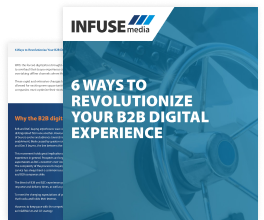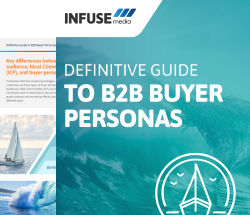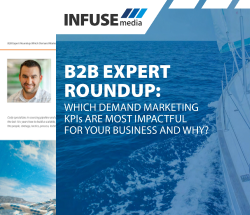The relationship funnel is a model that guides both sales and marketing processes as well as strategies for building strong, long-lasting relationships that contribute to client loyalty. These factors result in a greater client lifetime value (CLTV) and Return on Investment (ROI) from campaigns.
Why the Relationship Funnel Matters: A 4-Step Playbook for Generating Multiple Leads per Account
What is the relationship funnel?
As the B2B market continues to shift, so do buyer needs and behaviour. It is without a doubt that success will be determined by how well sales and marketing teams evolve to meet these changes—particularly the greater scrutiny of buyers and the competitive nature of the market.
Therefore, the greatest challenge for organisations looking to maintain and drive growth will be how to tackle these new obstacles to ensure and increase revenue streams. At the core of this, is the need to establish stronger relationships with clients and deliver them continuous support and value to foster loyalty and discourage them from exploring new options.
Building relationships takes time and significant investment, especially when driven at scale. As a result, it is imperative for teams to be empowered with the right sales model. Whilst the traditional sales funnel has been a staple for many since 1898, the relationship funnel has the potential to facilitate relationship-focused strategies and drive CLTV, as this article will explore.
The relationship funnel vs the sales funnel
Although the relationship funnel and sales funnel are similar in structure, the principal difference between the two models is their core focus and the actions conducted by the sales and marketing departments at each funnel stage.
The key differences between the sales and relationship funnel are as follows:
The sales funnel
The relationship funnel
Key focus
Revenue-focused
The sales funnel is designed to target key decision makers within buying groups, with generating sales being the priority.
Relationship-focused
Whilst revenue remains a crucial goal, the key focus is to establish relationships with buying groups and committee members to drive the buying process.
Sales cycle length
Shorter sales cycles
Although B2B buying decisions are always subject to change from shifts in buying behaviour, the sales funnel has a lower average time for purchases out of the two models.
Longer sales cycles
Sales cycles with the relationship funnel are generally longer to allow time for relationship building—with the idea that this will lead to higher ROI and CLTV from increased client loyalty.
Client relationship
duration
Shorter client
relationships
The traditional sales funnel usually does not prioritise longer relationships with prospects (since it is focused on conversions). However, this all depends on the strength of lead nurturing, personalisation strategies, and brand evangelism campaigns.
Longer client
relationships
The relationship funnel places the relationship at the centre of the entire process with the goal of motivating conversions and clients to repeat business—as well as become brand evangelists at the end of the sales cycle.
Priority metrics
Traditional KPIs
Lead cycle time
Conversion rates
Cost per lead (CPL)
Sales opportunities
Closed won
Average deal size
ROI
Client lifetime value (CLTV)
Long-term, relationship-focused KPIs
Renewals, up-sells, and cross-sells
Brand evangelism
Return on relationship (ROR)
Client acquisition costs (CAC)
Client lifetime value (CLTV)
Key focus
The sales funnel
Revenue-focused
The sales funnel is designed to target key decision makers within buying groups, with generating sales being the priority.
The relationship funnel
Relationship-focused
Whilst revenue remains a crucial goal, the key focus is to establish relationships with buying groups and committee members to drive the buying process.
Sales cycle length
The sales funnel
Shorter sales cycles
Although B2B buying decisions are always subject to change from shifts in buying behaviour, the sales funnel has a lower average time for purchases out of the two models.
The relationship funnel
Longer sales cycles
Sales cycles with the relationship funnel are generally longer to allow time for relationship building—with the idea that this will lead to higher ROI and CLTV from increased client loyalty.
Client relationship
duration
The sales funnel
Shorter client
relationships
The traditional sales funnel usually does not prioritise longer relationships with prospects (since it is focused on conversions). However, this all depends on the strength of lead nurturing, personalisation strategies, and brand evangelism campaigns.
The relationship funnel
Longer client
relationships
The relationship funnel places the relationship at the centre of the entire process with the goal of motivating conversions and clients to repeat business—as well as become brand evangelists at the end of the sales cycle.
Priority metrics
The sales funnel
Traditional KPIs
Lead cycle time
Conversion rates
Cost per lead (CPL)
Sales opportunities
Closed won
Average deal size
ROI
Client lifetime value (CLTV)
The relationship funnel
Long-term, relationship-focused KPIs
Renewals, up-sells, and cross-sells
Brand evangelism
Return on relationship (ROR)
Client acquisition costs (CAC)
Client lifetime value (CLTV)
Return On Relationship
Essentially, this is the value that businesses receive from nurturing relationships with their clients. This value includes benefits from social media activities such as social media engagement and followers, as well as more direct action such as referrals, recommendations, loyalty, and repeat business.
This metric is the most direct measure of success for the relationship funnel.
Client Lifetime Value (CLTV)
Determines the total amount of revenue that a company can expect to generate from a single client. This is especially relevant with relationship funnel marketing because it can indicate a client’s willingness to continue engaging with a brand and its solutions.
A high CLTV rate indicates a higher level of brand trust, as well as a greater degree of success across marketing and sales efforts.
Engagement Rate
Allows businesses to assess the average number of interactions your brand and content receive across channels. Whilst engagement rate does assist in determining if content is correct for target audiences, it also shows a company’s brand awareness and equity through engagements from clients and followers.
In cases where a brand is attempting to build an online community and become a thought leader in their field, this metric is useful in gauging success.
Client Retention
This measures how many of your clients you retain over a certain period of time. This metric can be further broken down into the number of clients a certain solution or account manager retains over a specified amount of time. This is a direct indicator of how satisfied clients are with a brand’s service, solutions, and overall experience provided.
Net Promoter Score (NPS)
This KPI gauges the probability that clientele would refer a company to someone they know. This metric usually comes with direct feedback from clients making it an invaluable tool for understanding the sentiments that they have for the brand in their own words. Due to the direct feedback involved, it also usually indicates areas of service that could use improvement.
Visit our article on how to revolutionise your
B2B digital experience and boost ROI

Enhanced revenue & client retention
The first and most obvious benefit of prioritising relationships and personal connection with the use of relationship funnel marketing is that it encourages client retention. Not only will this assist in securing a steady source of income, but it can also have a direct impact on improving revenue. Indeed, according to research by Bain & Company, increasing client retention by 5% can increase profits by 25% to 95%. In addition, according to an infographic compiled by Invesp, the opportunity to sell to an existing client is 60%-70%, whilst selling to a new client is only 5%-20%. This highlights the fact that prioritising client relationships is not only beneficial to client experience, but also to maintaining and driving revenues as well.
Increased brand equity
Using the relationship funnel also assists in increasing brand equity, as the improvement in client experience and satisfaction results in more brand ambassadors. These individuals will usually share positive experiences about the brand both online and within their own social and professional circles, thus improving the public perception of the brand and its reputation for excellence. In addition, INFUSE’s 2023 market surveys found that 48% of buyers gather information on solutions and brands from their peers. A positive reputation that is corroborated by existing clients will keep the brand top of mind for potential leads that may already be qualified.
Higher quantities of quality data
To establish relationships and create personal connections, brands must closely understand the needs and pain points of their leads and clients. Whilst this initially requires large quantities of information in the awareness stage of the buyer’s journey, it also provides a great deal of quality data as leads and clients interact with the brand more directly.
This data gleaned from close relationships with leads and clients can be used to craft messaging for similar leads in the awareness stage—reducing the need for less generalised data from Client Relationship Management solutions (CRMs), as well as third-party data sources. According to Salesforce’s 2022 State of the Connected Customer, 77% of clients expect companies to understand their unique needs and expectations, so gaining quality data directly from leads and clients themselves will be extremely valuable.
More precise targeting
Richer data leads to more accurate personalisation. More accurate personalisation will lead to an improved client experience and, as a result, a higher conversion rate. It should be noted that whilst targeting will be more precise, it will likely mean that fewer leads can be targeted at any one time as the cost and resources of individualised targeting will be higher.
Drive intended outcomes with campaigns with
accurate targeting and buyer personas

Human-to-Human marketing (H2H)
A common misconception about B2B buying decisions is that they are mostly driven by logical decision making. Whilst purchases do have to be approved by an entire committee of stakeholders (41% of buyer groups consist of 7-15 members), it is important to consider the individuals on a more personal, human level and the emotional side of decision making that may influence their purchases.
In fact, according to a three-year study by Motista, clients who feel an emotional or personal connection to a brand are far more valuable to retailers, because emotionally connected clients have a 306% higher lifetime value (LTV), stay with a brand for an average of 5.1 years vs. 3.4 years, and will recommend brands at a much higher rate (71% vs. 45%).
Here are 3 steps to implement H2H in your marketing activities:
1. Tell a compelling story
Making use of storytelling in your content or campaigns means that you can use more personable language that does not confuse or alienate the target audience. It also makes content more memorable whilst displaying the heart and creativity of the people behind the brand.
2. Create genuinely useful content
Whilst content is meant to assist in nurturing leads, it should also be based on genuine pain points, and in some cases, it does not need to link back to an existing solution for the business. Providing content that is not being published with the intention of making a sale (especially at the earlier stages of the marketing funnel), demonstrates genuine care and empathy from the brand, which builds trust and a more human and personal connection.
3. Provide support in online communities
Online forums and social media are popular places for people to flock to when in need of advice or answers. Brands that are often present and helpful (without pushing their business or solutions) on online forums tend to be perceived as more empathetic, in addition to presenting a more human side.
This is particularly true when the advice is being presented by a prominent member of the brand in their own voice. According to a 2019 Global Web Index and Reddit report, 82% of community site visitors said they would be welcoming of brands who choose to participate in communities.
4. Incorporate one-to-one email marketing
One-to-one marketing refers to a business sending a personalised email to a single prospect or lead. Whilst this will not be possible for all email correspondence due to the time and effort required, emails should be tailored to individual leads to address their pain points and needs. Whilst the tone should remain professional, brand representatives should communicate in an approachable way to aid leads in seeing the interaction as human-to-human.
Lead nurturing
The best way to build and properly establish relationships with leads in the relationship funnel is through lead nurturing. This method includes data-centric personalisation of lead touchpoints throughout the sales funnel. Data from analytics and CRM software, as well as independent research provides details about lead pain points, needs, and challenges to personalise content and touchpoints.
Personalisation is key to effective lead nurturing, as it provides the right information to leads at the right time. By providing educational content that assists them in solving current problems or achieving better performance , brands will be seen as trustworthy and helpful whilst keeping them top of mind. Indeed, according to 2022 research by Marketo, nurturing leads helps companies generate 50% more sales-ready leads at 33% lower costs.
3 steps for effective lead nurturing:
1. Audit and enhance your data sources
In order to nurture relationships with B2B leads, it is necessary to first understand who the leads are, their challenges, and what content will assist them. Perform regular audits of your CRMs, analytics, software, and databases to ensure that all forms of software are procuring accurate and current data from credible sources. Make sure to also check that your databases hold no duplicate, outdated, or inaccurate data.
It is important to also enhance your data sources with surveys, interviews, and feedback forms at various stages of the sales and marketing funnel. Collecting feedback from successful and failed conversions can also help to identify techniques that are working and those that need adjustment.
2. Build out a full-funnel content plan
Delivering useful content is an important part of nurturing relationships with leads. Use your data to develop a content plan for leads at all stages of the sales funnel. The content plan should allow for pivots as an agile approach will assist in ensuring that the content continues to meet the evolving needs of clients as the relationship grows.
Content helps leads better understand their professional and organisational needs and assists them in improving their approach or performance. Leads recognise the value in this and brands that provide such content will be perceived as knowledgeable and experienced. In fact, according to research by LinkedIn and Edelman, 54% of decision makers say they spend more than one hour per week reading and reviewing thought leadership content.
3. Utilise an omnichannel approach
In order to engage with leads, it is important to utilise the specific channels where they spend most of their time. Omnichannel marketing allows for a seamless experience across multiple channels where content and engagements on one channel inform and complement the others. This approach puts the lead’s journey and experience at the heart of the strategy, which is why it is so beneficial in nurturing relationships.
Is your lead nurturing delivering expected results?
Get the most value out of your nurturing with the
INFUSE playbook
Sales and marketing alignment
When nurturing a relationship with B2B leads, it is important to consider their full journey through the relationship funnel. As such, marketing and sales department alignment is essential so leads do not feel a disconnect when moving from engaging with marketing to interacting with sales. It will also mean a higher likelihood of conversion as sales will have the benefit of updated lead data and the positive relationship fostered through lead nurturing. In fact, according to a 2020 LinkedIn study, 87% of sales and marketing leaders say collaboration between sales and marketing enables critical business growth.
Here are 3 steps to align sales and marketing departments:
1. Collaborate on lead scoring
Ensure collaboration when defining a target market, ICP, and buyer personas, because each team will have unique data and insights to share.
2. Coordinate marketing campaigns with sales
Ensure that the sales team has full line of sight of what campaigns and content are being launched and have regular meetings to align on the goals and strategy of each. Provide the sales team with sales enablement content to assist them in converting leads generated from discussed campaigns.
3. Share analytics and reports
As sales and marketing often have separate analytics software and reports for their activities, sharing this information will assist both departments in improving their approach and crafting a seamless experience for leads as they progress throughout the buyer’s journey.
Boost your revenue with effective sales and
marketing alignment best practices
ABM also encourages the alignment of the sales and marketing departments, which (as mentioned earlier), lends itself well to relationship funnel marketing as it optimises the entire buyer and client journey from the start to their conversion.
Overall, ABM helps to narrow down the focus of the relationship funnel strategy by identifying and prioritising the most valuable accounts and providing a more personalised approach to engagement. This can lead to more efficient marketing and sales efforts, driving greater revenue and growth.
Learn how to achieve true ABM in 2023
with the latest CX and UX insights

Building relationships
(TOFU - Awareness Stage)
At this point of the relationship funnel, leads are in the awareness stage of their buyer’s journey and will either be aware but uneducated about their problem (or completely unaware that they have one).
Useful educational content here will therefore be important to start the process of building relationships. In order to do this, a thorough understanding of leads’ pain points, needs, and goals is essential.
What is Voice of the Client (VOC)?
VOC is defined by HubSpot as 'a research method that is used to collect client feedback. A VOC program can help you capture how your clients feel about your business, product, or service, giving you insights that can help you create a stronger client experience'.
1. Increase detail and quantity of data
The manner of targeting required for relationship funnel marketing demands large amounts of in-depth data in order to begin building genuine relationships with leads. Acquiring Voice of the Client (VOC) data, alongside the usual segmentation and intent data procured by CRM and other data sourcing software is an effective way to do this.
VOC data can be obtained through:
Social listening
Target market focus groups
Forms and reviews
Feedback from client-facing staff
Website live chats
Recorded sales calls data
The data gathered with these methods will provide more direct insight into the challenges and goals of leads whilst also framing this information in the language that leads themselves use (which can then be utilised in content to increase its engagement). Ensuring that the sales team is practicing active listening with clients to glean useful information will also be helpful in gathering VOC data.
2. Map your lead’s relationship journey
Creating a lead journey map will assist in understanding the details of each interaction leads have with the brand at different touchpoints. It will also allow businesses to identify what content, activities, and interactions are helping leads build relationships with the brand.
Mapping a lead’s relationship journey includes information such as how leads discovered the brand, what content they first interacted with, and what questions they were seeking answers to during their search. In fact, in a 2018 client mapping relationship exercise, SuperOffice found that a 'free trial' was not part of their lead’s buying process as they much preferred to sign up for a live demo. This information led to a new website structure that used 'Get demo' as the primary call to action (CTA), leading to more than double the number of sign-ups.
Below you will find a basic example of relationship journey mapping (keep in mind that every brand/lead relationship journey will look different).



Search engine
LinkedIn posts
Content syndication sites
Insights/blog page
Website - Offerings
Website - Store page
Review sites
LinkedIn / Facebook specials
Service emails
Support emails
Billing
Facebook specials

Search engine
LinkedIn posts
Content syndication sites
Insights/blog page

Website - Offerings
Website - Store page
Review sites
LinkedIn / Facebook specials

Service emails
Support emails
Billing
Facebook specials
3. Audit UX of website, campaign landing pages, and email layouts
The difference between a successful campaign and a failed one can often come down to an optimised layout and user-friendly interface. Utilising software to track a lead’s journey on the brand website, landing pages, and email, including where they linger and where they drop off can assist businesses in tweaking their layouts to allow leads to:
Navigate with ease
Understand the information and messages the brand is trying to relay
Find the necessary links to more helpful information or call to actions quickly and easily
According to 2021 research by Top Design Firms, 42% of people will leave a website because of poor functionality and in HubSpot’s 2020 surveys, over 20% of marketers said that email design was improving their email engagement. This highlights the importance of investigating what layouts are the most comfortable for your audience.
In addition, ensuring that web and email interfaces and designs are optimised for mobile is also very important since 59.1% of global web traffic comes from mobile devices (Statista, 2023).

Make use of email marketing
Email is one of the most direct methods of interaction with leads, which is why it forms an important part of nurturing relationships with them. In addition, email marketing will allow you to interact with leads where they are most comfortable, as 46% of smartphone users prefer to receive communications from businesses via email, according to Statista.
In order to effectively nurture relationships, emails should be personalised and segmented as much as possible to ensure that they are consistently providing relevant and valuable information. Whilst automation and a one-to-many approach will always be necessary due to high volumes of leads, where possible a one-to-one approach will be the most beneficial in fostering a relationship with multiple leads from a single account.
Utilise client orientation
Client orientation is a marketing strategy that puts the needs of the client ahead of the needs of the business. This means delivering content, providing guidance, and answering questions in online communities in a way that does not push the brand or its solutions, but rather seeks to meet the needs and goals of the leads.
In order to do this, it is important to put a client orientation process in place for all departments and ensure organisation-wide training. A thorough understanding of leads’ needs, challenges, and goals is essential to putting such a process in place, so direct feedback from leads and clients will be helpful in pivoting the client orientation strategy and approach as necessary.
Incorporate Account Based Experience (ABX)
ABX is a marketing approach that focuses on providing a superior personalised experience to members of the buying committee of key accounts. This is an ideal strategy for use in the relationship funnel as it allows for greater data-centric personalisation at a lower cost due to the targeted nature of ABX. With the number of targeted individuals being smaller and more refined, more resources and labour can be utilised for sourcing detailed information on leads and crafting hyper-personalised content, emails, and touchpoints to effectively nurture relationships.
Live demonstrations
Newsletters
Case studies and testimonials
Webinars
Sales emails
These content assets should provide positive experiences that encourage trust and loyalty. This means all touchpoints should provide value, be easy to access and understand, and allow easy follow-up for leads who have questions.
Social selling is also a helpful method that can be used to improve leads’ brand experience. This sales technique involves the sales department contacting leads directly through social media to assist them with questions, provide explanations, and suggest further reading (or watching) material to improve their understanding.
The positive experiences that leads enjoy when interacting with the brand also mean that a business is more likely to generate multiple leads from a single account because of the value gained by leads individually with this strategy. This is where relationship selling techniques tend to differ from traditional sales methods as the focus of the sales process moves from trying to fill the sales pipeline to assisting leads and improving their overall experience.
Discovery
Judgement
Integrity
Empathy
Trust
In addition, the activities that seek to improve these key metrics are also scored by clients with the following 5 criteria:
Preparation
Presentation
Issue resolution
Speed/efficiency
Ease of interaction
These metrics, in combination with the KPIs mentioned earlier in the article, can be used to effectively measure the performance of marketing within the relationship funnel whilst improving client service and satisfaction for existing clients.

Discover which demand marketing
KPIs are most impactful for your
business with our B2B expert roundup

Key takeaways
The relationship funnel is a beneficial lead experience-orientated strategy that can be used in conjunction with the traditional sales and marketing funnel to build relationships with leads, improve conversion rates, reduce churn, and grow your business.
The implementation of H2H, lead nurturing, and sales and marketing alignment will aid in implementing the relationship funnel effectively.
ABM complements the relationship funnel due to a more account-targeted focus, high levels of personalisation, and the need for sales and marketing alignment.
Increased quality and quantity of data, mapping lead relationship journeys, and auditing layouts for email and web are essential for building relationships.
Email marketing, client orientation, and ABX are useful strategies for building trust and loyalty in the relationship funnel.
Ensuring that all touchpoints are a positive experience for leads will garner trust and loyalty resulting in a positive relational experience.
Judging the success of the relationship funnel requires a qualitative approach gained through direct feedback from leads and clients.
Get in touch with our demand experts at [email protected]
to build lead-orientated, experience-driven demand programs that
exceed your ROI expectations











